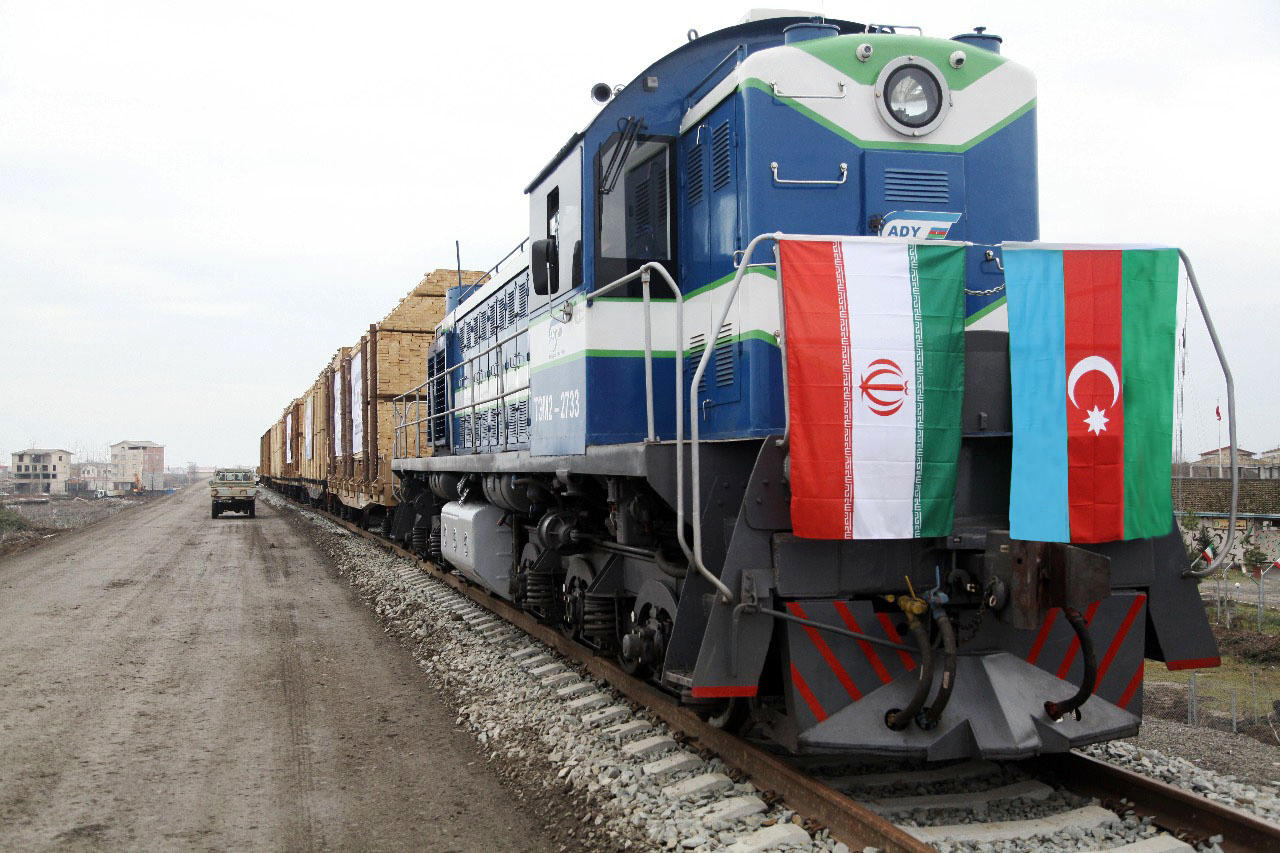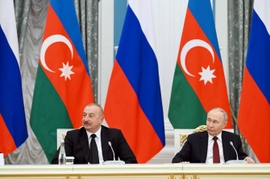Azerbaijan and Iran reached an agreement to build a multi-modal transport route to ensure access to the Nakhchivan Autonomous Republic, President Ilham Aliyev said in a statement on Tuesday.
The agreement provides for the construction of trans-border highway and railway lines to restore land connectivity with Nakhchivan.
On October 6, Azerbaijani Deputy Prime Minister Shahin Mustafayev and Iranian Minister of Roads and Urban Development Mehrdad Bazrpash attended a groundbreaking ceremony on the interstate border for a highway bridge over the Araz River.
The new bridge will connect Azerbaijan’s Zangilan district with the East Azerbaijan Province in Iran.
“The agreements reached after the meeting in Astara are being implemented. The cargo transportation volume will increase after the Aghband road and the bridge are built. This road will stretch to Julfa,” Bazrpash said at the groundbreaking ceremony, referring to a border district in Nakhchivan.
The deal was an alternative to the Zangezur Corridor running through Armenia, after Yerevan refused transit access claiming it could jeopardize the country’s sovereignty.
Yerevan continually postponed, and eventually canceled, the trilateral inter-ministerial meetings, also attended by Russia, that would have facilitated the construction of road and rail connections on the Zangezur Corridor. Armenia alleges that Azerbaijan seeks to make the multi-modal route “extraterritorial.”
The Zangezur Corridor’s launch would enable Azerbaijan to establish a direct connection with Nakhchivan, an autonomous republic of the country located between Iran, Armenia and Türkiye.
Nakhchivan became an exclave separated from the Azerbaijani mainland after the Soviet occupation of the South Caucasus region in 1920. Following the region’s incorporation, Soviet rulers transferred some of Azerbaijan's territories, including the historic region of Zangezur that borders Nakhchivan, to the newly created Armenian state.
Armenia’s military aggression against Azerbaijan in the early 1990s aggravated Nakhchivan’s isolation. All energy, electricity, and transport connections, including highways and railway links, to Nakhchivan were closed by Armenia.
Currently, land connections with Nakhchivan are available via either Iran or Türkiye.
Azerbaijan prioritized the Zangezur Corridor’s launch following the 44-day war with Armenia in 2020.
Armenia and Azerbaijan have long been at odds over the latter’s Karabakh (Garabagh) region. Following the dissolution of the Soviet Union in 1991, Armenia launched a military campaign against Azerbaijan that lasted until a ceasefire deal was reached in 1994. As a result, Armenia occupied 20 percent of Azerbaijan’s internationally recognized territories. Over 30,000 ethnic Azerbaijanis were killed and one million expelled from those lands in a brutal ethnic cleansing campaign carried out by Armenia.
On September 27, 2020, the decades-old conflict between the two countries escalated after Armenian forces, deployed in occupied Azerbaijani lands, shelled military positions and civilian settlements of Azerbaijan. During the counter-attack operations, Azerbaijani forces liberated over 300 settlements, including the cities of Jabrayil, Fuzuli, Zangilan, Gubadli, and Shusha, from nearly 30 years of illegal Armenian occupation. The war concluded with a trilateral statement signed on November 10, 2020, under which Armenia returned the occupied Aghdam, Kalbajar, and Lachin districts to Azerbaijan.
Paragraph 9 of the tripartite document specified Armenia’s obligation to “unblock” and “guarantee the security of transport connections,” and to “arrange unobstructed movement of persons, vehicles and cargo in both directions,” between “the western regions of the Republic of Azerbaijan and the Nakhchivan Autonomous Republic.”
In less than 3 years, over two-thirds of 110.4-kilometer single-track railway segment of the Zangezur Corridor, passing through the Jabrayil district to the border village of Aghband in Zangilan was laid by the Azerbaijan Railways Company (ADY).
Three tunnels, several dozen bridges, and nine railway stations will be built along the corridor. Construction by Turkish companies of a 418-meter railway bridge across the Hakari River will be completed soon.
Although the government of Azerbaijan plans to commence the domestic portion of the Zangezur Corridor sometime in 2024, the authorities of Armenia refuse to deliver on their legally binding commitments.
Zangezur Corridor in broader context
In addition to resuming the direct connection between Azerbaijan’s mainland and Nakhchivan, the Zangezur Corridor will enable an all-new transcontinental transport route. It is expected to plug into the Nakhchivan-Kars railway, a line between Nakhchivan and Türkiye. The government of Azerbaijan plans to complete the domestic portion of the railroad by the end of 2024.
Connection with the Nakhchivan-Kars railway and further linking with the Turkish railway grid will pave the way for the Zangezur Corridor into the European markets. With its potential to form a part of the global routes, the Zangezur corridor is expected to contribute to the Eurasian economies with a nominal GDP of $1.1 trillion.
China is interested in leveraging the corridor’s potential in the Belt and Road Initiative project. The Zangezur Corridor also fits in the plans of the stakeholders in the East-West Transport Corridor, known also as the Middle Corridor, which is seen as a modern twist of the ancient Silk Road connecting the markets in China and East Asia with the European markets.







 President Ilham Aliyev shed light on the evolving contours of the peace process with Armenia during an international conference in Baku this week. ...
President Ilham Aliyev shed light on the evolving contours of the peace process with Armenia during an international conference in Baku this week. ...
 Azerbaijan and Armenia started the process of demarcation of their border on Tuesday, with the installation of the first border markers based on ge...
Azerbaijan and Armenia started the process of demarcation of their border on Tuesday, with the installation of the first border markers based on ge...
 President Aliyev emphasized the critical role of the North-South Transport Corridor in fostering transport cooperation between Azerbaijan and Russi...
President Aliyev emphasized the critical role of the North-South Transport Corridor in fostering transport cooperation between Azerbaijan and Russi...
 Iran and Pakistan have signed eight cooperation documents in various fields, and agreed to strengthen ties to fight terrorism in the region.
Iran and Pakistan have signed eight cooperation documents in various fields, and agreed to strengthen ties to fight terrorism in the region.
 As the conflict between Ukraine and Russia escalates, the strategic importance of Kharkiv, Ukraine's second-largest city, has come sharply into focus.
As the conflict between Ukraine and Russia escalates, the strategic importance of Kharkiv, Ukraine's second-largest city, has come sharply into focus.



